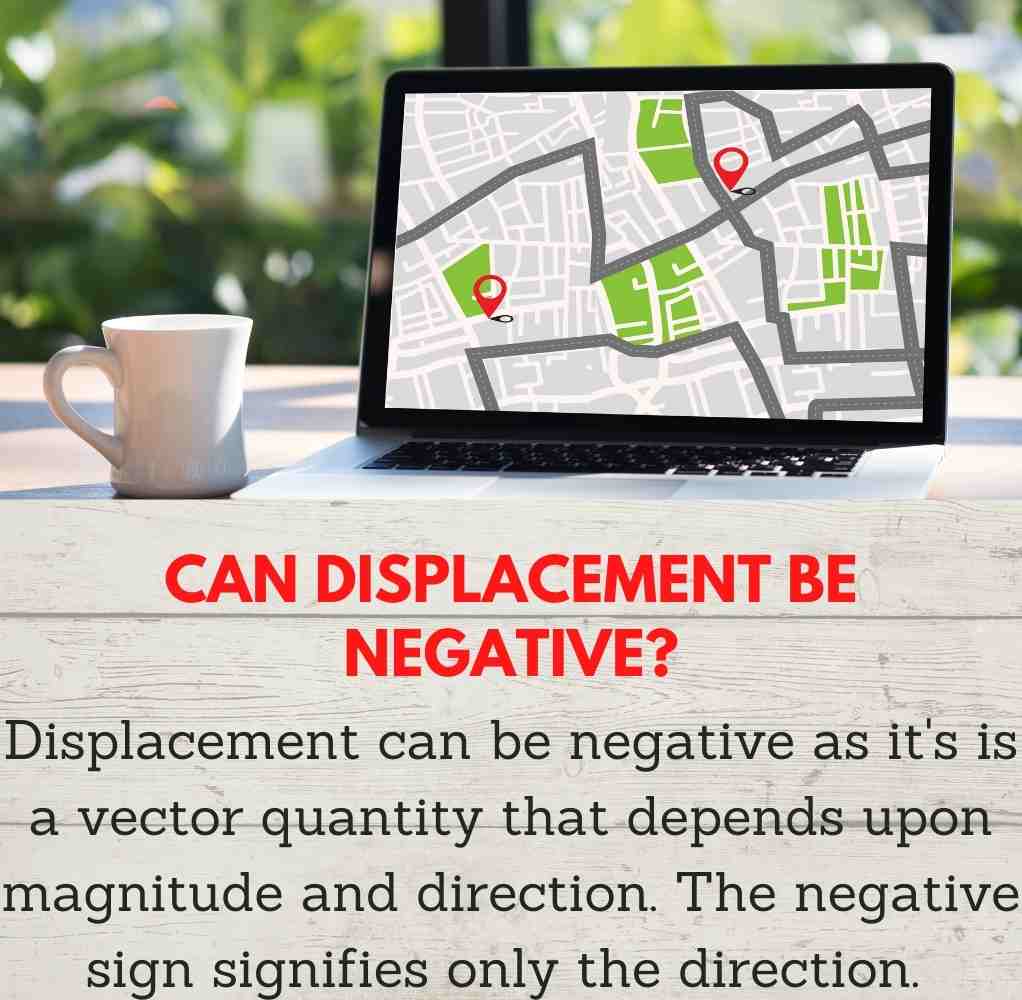Can displacement be negative: Yes, displacement can be negative as it is a vector quantity that depends upon magnitude and direction. The negative sign signifies only the direction.

Table of Contents
Negative Displacement
- The displacement of an object is the smallest distance between the initial and final positions of the object in a given time period.
- The magnitude of displacement is always positive.
- Displacement is a vector quantity that has a positive or negative sign that indicates its direction.
- If the displacement is to the right, the sign is always positive; if the displacement is to the left, the sign is always negative.
- The displacement will be zero if it does not move or if it retraces the path and returns to the original starting location.
Displacement Formula
Displacement is defined as a change in an object’s position. The following equation may be used to define it mathematically:
Displacement=Δx=x2−x1
Whereas x2 refers to the value of the final position and x1 refers to the value of the initial position.
Δx is the symbol used to represent displacement.
Units of Displacement
- The standard unit of displacement in the International System of Units ( SI ) is the meter (m).

What is a position?
A position is a place where someone or something is or has been placed. In physics, the position is commonly represented as a number on an axis. A vector is a number that has a direction. A scalar is a number that has no meaning in terms of direction. The position is a vector because direction matters.
Key Points
- The unit of displacement is a meter.
- Displacement can be negative or positive.
- Usually, displacement acting toward the right is taken as positive.
- The magnitude of the displacement is always a positive quantity.
- Displacement acting towards the left is taken as a negative.
- Can displacement be negative? Yes

Negative Displacement In simple words
Displacement is a vector quantity. This implies it has a direction as well as a magnitude and is graphically represented as an arrow pointing from the starting point to the ending location.
A plus or minus sign can be used to denote the direction of displacement in one-dimensional motion. When you start a problem, you should decide which way is positive—usually to the right or up, although you are free to choose positive in any direction.
Examples of Displacement
- If you’re driving down the road, you can set up a coordinate system in which travelling ahead is positive and going backwards is negative. Simply driving backward results in a negative displacement from the origin.

Daily Life Examples of Negative Displacement
Negative displacement refers to a decrease in position, distance, or volume in a particular direction. Here are some examples of negative displacement:
- A car moving backwards along a road
- A ball rolling downhill
- A fluid being drained from a container
- A spring being compressed
- An object is moved closer to a reference point
- A sound wave moving away from the source and getting weaker in amplitude
- An athlete running backwards on a track
- A cyclist riding in reverse on a path
Displacement-time graphs
- Displacement-time graphs show how a moving object’s displacement changes over time.
- The slope, or gradient, of the line in a displacement-time graph equals the velocity of the object.
- The quicker the item moves, the steeper the line (and the larger the gradient).
Dimension of Displacement
A displacement has dimension [L].

Quick Links

Quick Answers
| Can displacement be zero? | Yes, even though the distance is not zero, the displacement can be zero. |
| Can displacement be greater than distance? | The displacement is the shortest distance between two points, with a magnitude less than or equal to the distance. |
| What is an example of negative displacement? | When you travel forward with reference to your reference point (original position), the displacement is positive; when you go backwards with reference to the beginning position, the displacement is negative. |
Can Velocity be Negative?
To answer the question “can velocity be negative“, we need to understand vector quantities.
In vectors, the negative sign only represents the direction and nothing else. Positive and negative signs depend upon our choice of the coordinate system.
Velocity is a vector quantity, so velocity can be negative depending on its direction.
Can Force be Negative?
The answer to the question “can force be negative?” is simply yes.
Force is a vector variable that depends on magnitude and direction. It can be negative. The negative symbol just denotes the direction.
Related Links
Mechanical Energy| 7 Examples
Light Energy| 5- Easy Examples
Instantaneous Velocity| Easy Key Points
Momentum Equation| Examples
Kinetic Energy
Summary
- The answer to the question “Can displacement be negative?” is simply yes.
- Displacement is a vector quantity and depends upon magnitude and direction.
- The displacement depends upon the speed and direction of an object.
- Velocity is the rate of change of displacement with respect to time.
Frequently Asked Questions (FAQs)
1. What is the simple definition of displacement?
The term “displacement” means that an object has been relocated or displaced in a specific direction. It is a vector quantity.
2. What is the net force?
The vector sum of all the forces acting on an object is the net force. That is, the net force is equal to the sum of all forces, taking into mind that a force is a vector, and two forces of identical size and opposing direction cancel each other out.
3. Can displacement be negative?
Displacement can be negative since it is a vector variable that depends on magnitude and direction. The negative sign just indicates the direction.
4. What is a state function?
A state function is a property that depends on the state of a system and is independent of the path taken to get it. Pressure and temperature, for example, are state functions.
5. Can momentum be negative?
Momentum is a vector quantity that is calculated by multiplying the mass of an item by its velocity. If the item’s velocity is negative, i.e., the object is travelling in a negative direction, the momentum will be negative as well. Check the full article here“Can momentum be negative?”.
6. Can kinetic energy be negative?
Kinetic energy can never be a negative quantity. It is never less than or equal to zero.
A moving object’s kinetic energy equals one-half the product of its mass and the square of its velocity.
Because an object’s mass can never be zero, the square of velocity results in a positive response.
Kinetic energy, as a result, can never be negative.
Please refer to the full article“Can kinetic energy be negative?”.
7. Damped oscillation definition?
A damped oscillation is one that fades away over time. Examples include a swinging pendulum, a weight on a spring, and a resistor-inductor-capacitor (RLC) circuit.
8. What is centripetal acceleration?
Centripetal acceleration is the acceleration felt by a moving body travelling in a circular route. It is pointing towards the circle’s centre.
9. Crest of a wave?
The crest of a wave is the portion of the transverse waves above the mean level. The trough of a transverse wave is the section of the wave below the mean level.
10. gauge pressure?
Gauge Pressure is often known as overpressure, it is the pressure in a system that is greater than atmospheric pressure. Because gauge pressure is zero-referenced against ambient air (or atmospheric) pressure, gauge pressure values include atmospheric pressure.
Author
Umair Javed
Umair has been working at Whatsinsight since 2020 as a content writer.
He has a Masters degree in Materials Science.
More Interesting Topics
- BCl3 Lewis Structure in four simple steps - November 1, 2023
- PH3 Lewis Structure in four simple steps - October 8, 2023
- PF3 Lewis structure in four simple steps - September 24, 2023



